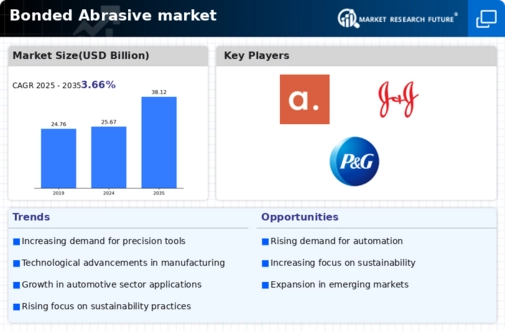Market Growth Projections
The Global Bonded Abrasive market Industry is projected to experience substantial growth, with estimates indicating a rise from 25.67 USD Billion in 2024 to 38.12 USD Billion by 2035. This growth trajectory suggests a compound annual growth rate of 3.66% from 2025 to 2035, reflecting the increasing demand across various sectors such as automotive, construction, and metalworking. The market's expansion is likely to be driven by technological advancements, rising industrial activities, and a growing emphasis on sustainability. These factors collectively indicate a robust future for the bonded abrasive market, positioning it as a vital component in numerous manufacturing processes.
Rising Construction Activities
The construction industry serves as a crucial driver for the Global Bonded Abrasive market Industry, as the demand for high-quality finishing tools escalates with increasing construction activities worldwide. Bonded abrasives are essential for tasks such as cutting, grinding, and polishing materials, which are integral to construction projects. The ongoing urbanization and infrastructure development initiatives across various regions are likely to bolster the demand for bonded abrasives. This trend suggests a sustained growth trajectory, potentially contributing to the market's compound annual growth rate of 3.66% from 2025 to 2035, as construction projects continue to proliferate.
Expansion of Metalworking Industry
The metalworking industry is a significant contributor to the Global Bonded Abrasive market Industry, driven by the need for precision tools in machining and fabrication processes. As industries such as aerospace, defense, and manufacturing expand, the demand for high-quality bonded abrasives is expected to increase. These abrasives are critical for achieving desired surface finishes and tolerances in metal components. The market's growth is further supported by the increasing adoption of automated machining processes, which require reliable and efficient abrasives. This sector's expansion could play a vital role in the overall market dynamics, enhancing the demand for bonded abrasives.
Growing Demand in Automotive Sector
The automotive sector is a pivotal driver for the Global Bonded Abrasive market Industry, as manufacturers increasingly rely on bonded abrasives for precision machining and surface finishing of components. The demand for high-performance abrasives is expected to rise due to the industry's shift towards lightweight materials and advanced manufacturing techniques. As the automotive sector evolves, the need for efficient and durable abrasives becomes paramount, potentially contributing to the market's projected growth to 25.67 USD Billion in 2024. This trend indicates a robust expansion trajectory, with the automotive industry likely accounting for a substantial share of the overall demand.
Technological Advancements in Abrasive Manufacturing
Technological innovations in the production of bonded abrasives are significantly influencing the Global Bonded Abrasive market Industry. Enhanced manufacturing processes, such as the introduction of advanced bonding agents and improved grain structures, lead to superior performance and longevity of abrasives. These advancements not only increase efficiency but also reduce production costs, making bonded abrasives more accessible to various industries. As a result, the market is poised for growth, with projections suggesting a rise to 38.12 USD Billion by 2035. This evolution in technology may also foster new applications, further expanding the market's reach.
Environmental Regulations and Sustainability Initiatives
Environmental regulations and sustainability initiatives are increasingly shaping the Global Bonded Abrasive market Industry. Manufacturers are under pressure to adopt eco-friendly practices, leading to the development of green abrasives that minimize environmental impact. This shift towards sustainable products is likely to attract environmentally conscious consumers and industries, thereby expanding the market. Companies that innovate in this area may gain a competitive edge, as sustainability becomes a key purchasing criterion. The emphasis on eco-friendly solutions may also drive research and development efforts, further influencing market dynamics and consumer preferences.




